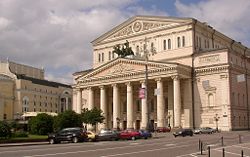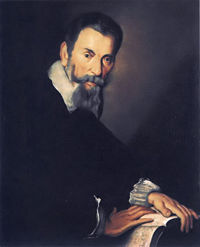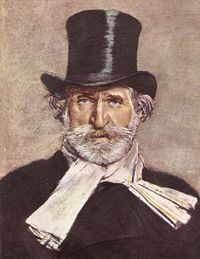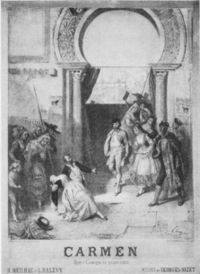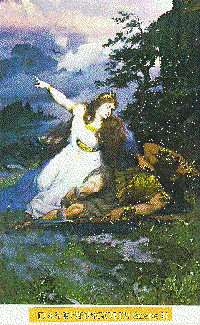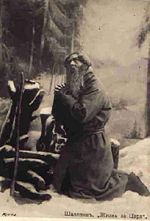Opera
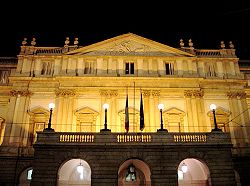
Opera is a form of theater in which the drama is conveyed wholly or predominantly through music and singing. Opera emerged in Italy around the year 1600 and is generally associated with the Western classical music tradition. Opera uses many of the elements of spoken theater such as scenery, costumes, and acting. Generally, however, opera is distinguished from other dramatic forms by the importance of song and conventions of vocal technique. The singers are accompanied by a musical ensemble ranging from a small instrumental ensemble to a full symphonic orchestra. Opera may also incorporate dance; this was especially true of French opera for much of its history.
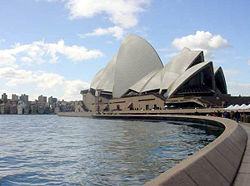
Background of Opera
Comparable art forms from various other parts of the world, many of them ancient in origin, exist and are also sometimes called "opera" by analogy, usually prefaced with an adjective indicating the region (for example, Chinese opera). These independent traditions are not derivative of Western opera, but are rather distinct forms of musical theatre. Opera is also not the only type of Western musical theatre: in the ancient world, Greek drama featured singing and instrumental accompaniment; and in modern times, other forms such as the musical have appeared.
Operatic terminology
The words of an opera are known as the libretto (literally "little book"). Some composers, notably Richard Wagner, have written their own libretti; others have worked in close collaboration with their librettists, e.g. Mozart with Lorenzo da Ponte. Traditional opera consists of two modes of singing: recitative, the plot-driving passages often sung in a non-melodic style characteristic of opera, and aria (an "air" or formal song) in which the characters express their emotions in a more structured melodic style. Duets, trios and other ensembles often occur, and choruses are used to comment on the action. In some forms of opera, such as Singspiel, opéra comique, operetta, and semi-opera, the recitative is mostly replaced by spoken dialogue. Melodic or semi-melodic passages occurring in the midst of, or instead of, recitative, are also referred to as 'arioso'. During the Baroque and Classical periods, recitative could appear in two basic forms: secco (dry) recitative, accompanied only by "continuo," which was often no more than a harpsichord; or accompagnato (also known as "stromentato") in which the orchestra provided accompaniment. By the nineteenth century, accompagnato had gained the upper hand, the orchestra played a much bigger role, and Richard Wagner revolutionised opera by abolishing almost all distinction between aria and recitative in his quest for what he termed "endless melody." Subsequent composers have tended to follow Wagner's example, though some, such as Stravinsky in his The Rake's Progress have bucked the trend. The terminology of the various kinds of operatic voices is described in Section 3 below.[1]
History
Origins
The word opera means "works" in Italian (from the plural of Latin opus meaning "work" or "labour") suggesting that it combines the arts of solo and choral singing, declamation, acting and dancing in a staged spectacle. Dafne by Jacopo Peri was the earliest composition considered opera, as understood today. It was written around 1597, largely under the inspiration of an elite circle of literate Florentine humanists who gathered as the "Florentine Camerata." Significantly, Dafne was an attempt to revive the classical Greek drama, part of the wider revival of antiquity characteristic of the Renaissance. The members of the Camerata considered that the "chorus" parts of Greek dramas were originally sung, and possibly even the entire text of all roles; opera was thus conceived as a way of "restoring" this situation. Dafne is unfortunately lost. A later work by Peri, the opera Euridice, dating from 1600, is the first opera score to have survived to the present day. The honour of being the first opera still to be regularly performed, however, goes to Claudio Monteverdi's Orfeo, composed for the court of Mantua in 1607.[2]
Italian opera
The Baroque era
Opera did not remain confined to court audiences for long; in 1637 the idea of a "season" (Carnival) of publicly-attended operas supported by ticket sales emerged in Venice. Monteverdi had moved to the city from Mantua and composed his last operas, Il ritorno d'Ulisse in patria and L'incoronazione di Poppea, for the Venetian theatre in the 1640s. His most important follower Francesco Cavalli helped spread opera throughout Italy. In these early Baroque operas, broad comedy was blended with tragic elements in a mix that jarred some educated sensibilities, sparking the first of opera's many reform movements, sponsored by Venice's Arcadian Academy which came to be associated with the poet Metastasio, whose libretti helped crystallize the genre of opera seria, which became the leading form of Italian opera until the end of the eighteenth century. Once the Metastasian ideal had been firmly established, comedy in Baroque-era opera was reserved for what came to be called opera buffa.[3]
Opera seria was elevated in tone and highly stylised in form, usually consisting of secco recitative interspersed with long da capo arias. These afforded great opportunity for virtuosic singing and during the golden age of opera seria the singer really became the star. The role of the hero was usually written for the 'castrato' voice; castrati such as Farinelli and Senesino, as well as female sopranos such as Faustina Bordoni, became in great demand throughout Europe as opera seria ruled the stage in every country except France. Italian opera set the Baroque standard. Italian libretti were the norm, even when a German composer like Handel found himself writing for London audiences. Italian libretti remained dominant in the classical period as well, for example in the operas of Mozart, who wrote in Vienna near the century's close. Leading Italian-born composers of opera seria include Alessandro Scarlatti, Vivaldi and Porpora.[4]
Reform: Gluck, the attack on the Metastasian ideal, and Mozart
Opera seria had its weaknesses and critics, and the taste for embellishment on behalf of the superbly trained singers, and the use of spectacle as a replacement for dramatic purity and unity drew attacks. Francesco Algarotti's Essay on the Opera (1755) proved to be an inspiration for Christoph Willibald Gluck's reforms. He advocated that opera seria had to return to basics and that all the various elementsâmusic (both instrumental and vocal), ballet, and stagingâmust be subservient to the overriding drama. Several composers of the period, including NiccolĂČ Jommelli and Tommaso Traetta, attempted to put these ideals into practice. The first to really succeed and to leave a permanent imprint upon the history of opera, however, was Gluck. Gluck tried to achieve a "beautiful simplicity." This is illustrated in the first of his "reform" operas, Orfeo ed Euridice, where vocal lines lacking in the virtuosity of (say) Handel's works are supported by simple harmonies and a notably richer-than-usual orchestral presence throughout.
Gluck's reforms have had resonance throughout operatic history. Weber, Mozart and Wagner, in particular, were influenced by his ideals. Mozart, in many ways Gluck's successor, combined a superb sense of drama, harmony, melody, and counterpoint to write a series of comedies, notably CosĂŹ fan tutte, The Marriage of Figaro, and Don Giovanni (in collaboration with Lorenzo Da Ponte) which remain among the most-loved, popular and well-known operas today. But Mozart's contribution to opera seria was more mixed; by his time it was dying away, and in spite of such fine works as Idomeneo and La Clemenza di Tito, he would not succeed in bringing the art form back to life again.[5]
|
Bel canto, Verdi and verismo
The 'bel canto' opera movement flourished in the early nineteenth century and is exemplified by the operas of Rossini, Bellini, Donizetti, Pacini, Mercadante and many others. Literally "beautiful singing," bel canto opera derives from the Italian stylistic singing school of the same name. Bel canto lines are typically florid and intricate, requiring supreme agility and pitch control.
Following the bel canto era, a more direct, forceful style was rapidly popularized by Giuseppe Verdi, beginning with his biblical opera Nabucco. Verdi's operas resonated with the growing spirit of Italian nationalism in the post-Napoleonic era, and he quickly became an icon of the patriotic movement (although his own politics were perhaps not quite so radical). In the early 1850s, Verdi produced his three most popular operas: Rigoletto, Il trovatore and La traviata. But he continued to develop his style, composing perhaps the greatest French Grand opera, Don Carlos, and ending his career with two Shakespeare-inspired works, Otello and the opera Falstaff, which reveal how far Italian opera had grown in sophistication since the early nineteenth century.
After Verdi, the sentimental "realistic" melodrama of verismo opera appeared in Italy. This was a style introduced by Pietro Mascagni's Cavalleria Rusticana and Ruggiero Leoncavallo's Pagliacci that came virtually to dominate the world's opera stages with such popular works as Giacomo Puccini's La Boheme, Tosca, and Madama Butterfly. Later Italian composers, such as Berio and Nono, have experimented with modernism.[6]
|
French opera
In rivalry with imported Italian opera productions, a separate French tradition was founded by the Italian Jean-Baptiste Lully at the court of King Louis XIV. Despite his foreign origin, Lully established an Académie Royale de Musique (Academy of Music) and monopolized French opera from 1672. Starting with Cadmus et Hermione, Lully and his librettist Philippe Quinault created tragédie en musique, a form in which dance music and choral writing were particularly prominent. Lully's operas also show a concern for expressive recitative which matched the contours of the French language. In the eighteenth century, Lully's most important successor was Rameau, who composed five tragédies en musique as well as numerous works in other genres such as opera-ballet, all notable for their rich orchestration and harmonic daring. After Rameau's death, the German Gluck was persuaded to produce six operas for the Parisian stage in the 1770s. They show the influence of Rameau, but simplified and with greater focus on the drama. At the same time, by the middle of the eighteenth century another genre was gaining popularity in France: opéra comique. This was the equivalent of the German singspiel, where arias alternated with spoken dialogue. Notable examples in this style were produced by Monsigny, Philidor and, above all, Grétry. During the French Revolutionary period, composers such as Méhul and Cherubini, who were followers of Gluck, brought a new seriousness to the genre, which had never been wholly "comic" in any case.
By the 1820s, Gluckian influence in France had given way to a taste for Italian bel canto, especially after the arrival of Rossini in Paris. Rossini's Guillaume Tell helped found the new genre of Grand opera, a form whose most famous exponent was another foreigner, Giacomo Meyerbeer. Meyerbeer's works, such as Les Huguenots emphasised virtuoso singing and extraordinary stage effects. Lighter opéra comique also enjoyed tremendous success in the hands of Boïeldieu, Auber, Hérold and Adolphe Adam. In this climate, the operas of the French-born composer Hector Berlioz struggled to gain a hearing. Berlioz's epic masterpiece Les Troyens, the culmination of the Gluckian tradition, was not given a full performance for almost a hundred years.
In the second half of the nineteenth century, Jacques Offenbach created operetta with witty and cynical works such as Orphée aux enfers; Charles Gounod scored a massive success with the opera Faust; and Bizet composed the opera Carmen, which, once audiences learned to accept its blend of Romanticism and realism, became the most popular of all opéra comiques. Massenet, Saint-Saëns and Delibes all composed works which are still part of the standard repertory. At the same time, the influence of Richard Wagner was felt as a challenge to the French tradition. Many French critics angrily rejected Wagner's music dramas while many French composers closely imitated them with variable success. Perhaps the most interesting response came from Claude Debussy. As in Wagner's works, the orchestra plays a leading role in Debussy's unique opera Pelléas et Mélisande (1902) and there are no real arias, only recitative. But the drama is understated, enigmatic and completely unWagnerian.
Other notable twentieth-century names include Ravel, Dukas, Roussel and Milhaud. Francis Poulenc is one of the very few post-war composers of any nationality whose operas (which include Dialogues of the Carmelites (Dialogues des carmélites)) have gained a foothold in the international repertory. Olivier Messiaen's lengthy sacred drama Saint François d'Assise (1983) has also attracted widespread attention.[7]
|
|||||
| Problems listening to this file? See media help. | |||||
German-language opera
The first German opera was Dafne, composed by Heinrich SchĂŒtz in 1627 (the music has not survived). Italian opera held a great sway over German-speaking countries until the late eighteenth century. Nevertheless, native forms developed too. In 1644, Sigmund Staden produced the first Singspiel, a popular form of German-language opera in which singing alternates with spoken dialogue. In the late seventeenth and early eighteenth centuries, the Theater am GĂ€nsemarkt in Hamburg presented German operas by Keiser, Telemann and Handel. Yet many of the major German composers of the time, including Handel himself, as well as Graun, Hasse and later Gluck, chose to write most of their operas in foreign languages, especially Italian.
Mozart's Singspiele, Die EntfĂŒhrung aus dem Serail (1782) and Die Zauberflöte (1791) were an important breakthrough in achieving international recognition for German opera. The tradition was developed in the 19th century by Beethoven with his Fidelio, inspired by the climate of the French Revolution. Carl Maria von Weber established German Romantic opera in opposition to the dominance of Italian bel canto. His Der FreischĂŒtz (1821) shows his genius for creating supernatural atmosphere. Other opera composers of the time include Marschner, Schubert, Schumann and Lortzing, but the most important figure was undoubtedly Richard Wagner.
Wagner was one of the most revolutionary and controversial composers in musical history. Starting under the influence of Weber and Meyerbeer, he gradually evolved a new concept of opera as a Gesamtkunstwerk (a "complete work of art"), a fusion of music, poetry and painting. In his mature music dramas,Tristan und Isolde, Die Meistersinger von NĂŒrnberg, Der Ring des Nibelungen and Parsifal, he abolished the distinction between aria and recitative in favour of a seamless flow of "endless melody." He greatly increased the role and power of the orchestra, creating scores with a complex web of 'leitmotivs', recurring themes often associated with the characters and concepts of the drama; and he was prepared to violate accepted musical conventions, such as tonality, in his quest for greater expressivity. Wagner also brought a new philosophical dimension to opera in his works, which were usually based on stories from Germanic paganism or Arthurian legend. Finally, Wagner built his own opera house at Bayreuth, exclusively dedicated to performing his own works in the style he wanted.
Opera would never be the same after Wagner and for many composers his legacy proved a heavy burden. On the other hand, Richard Strauss accepted Wagnerian ideas but took them in wholly new directions. He first won fame with the scandalous opera Salome and the dark tragic opera Elektra, in which tonality was pushed to the limits. Then Strauss changed tack in his greatest success, Der Rosenkavalier, where Mozart and Viennese waltzes became as important an influence as Wagner. Strauss continued to produce a highly varied body of operatic works, often with libretti by the poet Hugo von Hofmannsthal, right up until the opera Capriccio in 1942. Other composers who made individual contributions to German opera in the early twentieth century include Zemlinsky, Hindemith, Kurt Weill and the Italian-born Ferruccio Busoni. The operatic innovations of Arnold Schoenberg and his successors are discussed in the section on modernism.[8]
|
|||||
| Problems listening to this file? See media help. | |||||
English-language opera
England's first notable composer working in operatic formats was John Blow, the composer of the opera Venus and Adonis, often thought of as the first true English-language opera. Blow's immediate successor was the far more well-known Henry Purcell. Despite the success of his masterwork Dido and Aeneas, in which the action is furthered by the use of Italian-style recitative, much of Purcell's best work was not involved in the composing of typical opera but instead he usually worked within the constraints of the semi-opera format, where isolated scenes and masques are contained within the structure of a spoken play. The main characters of the play tend not to be involved in the musical scenes, which means that Purcell was rarely able to develop his characters through song. Despite these hindrances, his aim (and that of his collaborator John Dryden) was to establish serious opera in England, but these hopes ended with Purcell's early death at the age of 36.
Following Purcell, for many years Great Britain was essentially an outpost of Italianate opera. Handel's opera serias dominated the London operatic stages for decades, and even home-grown composers such as Thomas Arne wrote using Italian models. This situation continued throughout the eighteenth and nineteenth centuries, including Michael Balfe, except for ballad operas, such as John Gay's The Beggar's Opera, which spoofed operatic conventions, and late Victorian era light operas, notably the Savoy Operas of W. S. Gilbert and Arthur Sullivan. French operetta was also frequently heard in London through the 1870s.
However, in the twentieth century, English opera began to assert more independence with works of Ralph Vaughn Williams and in particular Benjamin Britten, who in a series of fine works that remain in standard repertory today revealed an excellent flair for the dramatic and superb musicality. Today composers such as Thomas AdĂšs continue to export English opera abroad.[9]
|
|||||
| Problems listening to this file? See media help. | |||||
Also in the twentieth century, American composers like Gershwin, Gian Carlo Menotti, and Carlisle Floyd began to contribute English-language operas infused with touches of popular musical styles. They were followed by modernists like Philip Glass, Mark Adamo, John Coolidge Adams, and Jake Heggie.
Russian opera
Opera was brought to Russia in the 1730s by the Italian operatic troupes and soon it became an important part of entertainment for the Russian Imperial Court and aristocracy. Many foreign composers such as Baldassare Galuppi, Giovanni Paisiello, Giuseppe Sarti, and Domenico Cimarosa (as well as various others) were invited to Russia to compose new operas, mostly in the Italian language. Simultaneously some domestic musicians like Maksym Berezovsky and Dmytro Bortniansky were sent abroad to learn to write operas. The first opera written in the Russian language was Tsefal i Prokris by the Italian composer Francesco Araja (1755). The development of Russian-language opera was supported by the Russian composers Vasily Pashkevich, Yevstigney Fomin and Alexey Verstovsky.
However, the real birth of Russian opera came with Mikhail Glinka and his two great operas A Life for the Tsar, (1836) and Ruslan and Lyudmila (1842). After him in the nineteenth century in Russia there were written such operatic masterpieces as Rusalka and The Stone Guest by Alexander Dargomyzhsky, the opera Boris Godunov and Khovanshchina by Modest Mussorgsky, Prince Igor by Alexander Borodin, the opera Eugene Onegin and The Queen of Spades by Pyotr Tchaikovsky, and The Snow Maiden and Sadko by Nikolai Rimsky-Korsakov. These developments mirrored the growth of Russian nationalism across the artistic spectrum, as part of the more general 'Slavophilism' movement.
In the twentieth century, the traditions of Russian opera were developed by many composers including Sergei Rachmaninov in his works The Miserly Knight and the opera Francesca da Rimini, Igor Stravinsky in Le rossignol, Mavra, the opera Oedipus rex, and The Rake's Progress, Sergei Prokofiev in The Gambler, The Love for Three Oranges, The Fiery Angel (Prokofiev), Betrothal in a Monastery, and War and Peace; as well as Dmitri Shostakovich in the operas The Nose and Lady Macbeth of the Mtsensk District, Edison Denisov in the opera L'Ă©cume des jours, and Alfred Schnittke in Life With an Idiot, and the opera Historia von D. Johann Fausten.[10]
Other national operas
Spain also produced its own distinctive form of opera, known as zarzuela, which had two separate flowerings: one in the seventeenth century, and another beginning in the mid-nineteenth century. During the eighteenth century, Italian opera was immensely popular in Spain, supplanting the native form.
Czech composers also developed a thriving national opera movement of their own in the nineteenth century, starting with BedĆich Smetana who wrote eight operas including the internationally popular The Bartered Bride. AntonĂn DvoĆĂĄk, most famous for the opera Rusalka, wrote 13 operas; and LeoĆĄ JanĂĄÄek gained international recognition in the twentieth century for his innovative works including JenĆŻfa, The Cunning Little Vixen, and KĂĄĆ„a KabanovĂĄ.
The key figure of Hungarian national opera in the nineteenth century was Ferenc Erkel, whose works mostly dealt with historical themes. Among his most often performed operas are Hunyadi LĂĄszlĂł and BĂĄnk bĂĄn. The most famous modern Hungarian opera is BĂ©la BartĂłk's Duke Bluebeard's Castle. Erkel's Polish equivalent was Stanislaw Moniuszko, most celebrated for the opera Straszny DwĂłr.[11]
Contemporary, recent, and Modernist trends
Modernism
Perhaps the most obvious stylistic manifestation of modernism in opera is the development of atonality. The move away from traditional tonality in opera had begun with Wagner, and in particular the 'Tristan chord'. Composers such as Richard Strauss, Claude Debussy, Giacomo Puccini, Paul Hindemith and Hans Pfitzner pushed Wagnerian harmony farther with a more extreme use of chromaticism and greater use of dissonance.
Operatic Modernism truly began in the operas of two Viennese composers, Arnold Schoenberg and his acolyte Alban Berg, both composers and advocates of atonality and its later development (as worked out by Schoenberg), dodecaphony. Schoenberg's early musico-dramatic works, Erwartung (1909, premiered in 1924) and Die Gluckliche Hand display heavy use of chromatic harmony and dissonance in general. Schoenberg also occasionally used Sprechstimme, which he described as: "The voice rising and falling relative to the indicated intervals, and everything being bound together with the time and rhythm of the music except where a pause is indicated."
The two operas of Schoenberg's pupil Alban Berg, Wozzeck and the opera Lulu (left incomplete at his death) share many of the same characteristics as described above, though Berg combined his highly personal interpretation of Schoenberg's twelve-tone technique with melodic passages of a more traditionally tonal nature (quite Mahlerian in character) which perhaps partially explains why his operas have remained in standard repertory, despite their controversial music and plots. Schoenberg's theories have influenced (either directly or indirectly) significant numbers of opera composers ever since, even if they themselves did not compose using his techniques. Composers thus influenced include the Englishman Benjamin Britten, the German Hans Werner Henze, and the Russian Dmitri Shostakovich. (Philip Glass also makes use of atonality, though his style is generally described as minimalism, usually thought of as another twentieth century development.)
However, operatic modernism's use of dodecaphony sparked a backlash among several leading composers. Prominent among the vanguard of these was the Russian Igor Stravinsky. After composing obviously Modernist music for the Diaghilev-produced ballets Petrushka and The Rite of Spring, in the 1920s Stravinsky turned to Neoclassicism, culminating in his opera-oratorio Oedipus Rex.[12] When he did compose a full-length opera that was without doubt an opera (after his Rimsky-Korsakov-inspired works The Nightingale (1914), and Mavra (1922)), in the The Rake's Progress he continued to ignore serialist techniques and wrote an eighteenth century-style "number" opera, using diatonicism. His resistance to serialism proved to be an inspiration for many other composers.[13]
Other trends
A common trend throughout the twentieth century, in both opera and general orchestral repertoire, is the downsizing of orchestral forces. As patronage of the arts decreases, new works are commissioned and performed with smaller budgets, very often resulting in chamber-sized works, and one act operas. Many of Benjamin Britten's operas are scored for as few as 13 instrumentalists; Mark Adamo's two-act realization of the opera Little Women is scored for 18 instrumentalists.
Another feature of twentieth century opera is the emergence of contemporary historical operas. The Death of Klinghoffer and the opera Nixon in China by John Adams, and the opera Dead Man Walking by Jake Heggie exemplify the dramatization on stage of events in recent living memory, where characters portrayed in the opera were alive at the time of the premiere performance. Earlier models of opera generally stuck to more distant history, re-telling contemporary fictional stories (reworkings of popular plays), or mythical/legendary stories.[14]
The Metropolitan Opera reports that the average age of its patrons is now 60. Many opera companies, have experienced a similar trend, and opera company websites are replete with attempts to attract a younger audience. This trend is part of the larger trend of greying audiences for European classical music since the last decades of the twentieth century.[15]
From musicals back towards opera
Also by the late 1930s, some theatrical musicals began to be written with a more operatic structure. These works include complex polyphonic ensembles and reflect musical developments of their times. Porgy and Bess, influenced by jazz styles, and the operetta Candide, with its sweeping, lyrical passages and farcical parodies of opera, both opened on Broadway but became accepted as part of the opera repertory. Show Boat, West Side Story, Brigadoon, the musicals Sweeney Todd, Evita and others tell dramatic stories through complex music and are now sometimes seen in opera houses. Some musicals, beginning with the rock opera Tommy (1969) and Jesus Christ Superstar (1971), are through-composed, written with recitative instead of dialogue, telling their emotional stories predominantly through the music, and are styled rock operas.
Operatic voices
Singers and the roles they play are initially classified according to their vocal ranges. Male singers are classified by vocal range as bass, bass-baritone, baritone, tenor and countertenor. Female singers are classified by vocal range as contralto, mezzo-soprano and soprano.[16] Additionally, singers' voices are loosely identified by characteristics other than range, such as timbre or color, vocal quality, agility, power, and tessitura. Thus a soprano may be termed a lyric soprano, coloratura, soubrette, spinto, or dramatic soprano; these terms the roles most suitable to the singer's vocal characteristics. The German Fach system is an especially organized system, although not fully describing a singing voice, associate the singer's voice with of vocal classification. A particular singer's voice may change drastically over his or her lifetime, rarely reaching vocal maturity until the third decade, and sometimes not until middle age.
Brief Overview of Histories
The soprano voice has typically been used throughout operatic history as the voice of choice for the female protagonist of the opera in question. The current emphasis on a wide vocal range was primarily an invention of the Classical period. Before that, the vocal virtuosity, not range, was the priority, with soprano parts rarely extending above a high A (Handel, for example, only wrote one role extending to a high C), though the castrato Farinelli was alleged to possess a top F. The contralto register enjoys only a limited operatic repertoire; hence the saying that contraltos only sing "Witches, bitches, and britches (pants roles)," and in recent years many of the trouser roles from the Baroque era have been assigned to countertenors.
The tenor voice, from the Classical era onwards, has traditionally been assigned the role of male protagonist. Many of the most challenging tenor roles in the repertory were written during the bel canto era, such as Donizetti's sequence of 9 Cs above middle C during La fille du régiment. With Wagner came an emphasis on vocal weight for his protagonist roles, the vocal category of which is described by the term heldentenor. Bass roles have a long history in opera, having been used in opera seria for comic relief (and as a contrast to the preponderance of high voices in this genre). The bass repertoire is wide and varied, stretching from the buffo comedy of Leporello in Don Giovanni to the nobility of Wotan in Wagner's Ring Cycle. In between the bass and the tenor is the baritone.
Notes
- â General information in this section comes from the relevant articles in The Oxford Companion to Music, by. P. Scholes (10th ed., 1968).
- â Oxford Illustrated History of Opera, Chapter 1; articles on Peri and Monteverdi in The Viking Opera Guide.
- â Before such elements were forced out of opera seria, many libretti had featured a separately unfolding comic plot as sort of an "opera-within-an-opera." One reason for this was an attempt to attract members of the growing merchant class, newly wealthy, but still less cultured than the nobility, to the public opera houses. These separate plots were almost immediately resurrected in a separately developing tradition that partly derived from the commedia dell'arte, (as indeed, such plots had always been) a long-flourishing improvisatory stage tradition of Italy. Just as intermedi had once been performed in-between the acts of stage plays, operas in the new comic genre of "intermezzi," which developed largely in Naples in the 1710s and '20s, were initially staged during the intermissions of opera seria. They became so popular, however, that they were soon being offered as separate productions.
- â Oxford Illustrated History of Opera, Chapters 1-3.
- â Neal Zaslaw, Man and Music: the Classical Era (Macmillan, 1989); entries on Gluck and Mozart in The Viking Opera Guide.
- â Oxford Illustrated History of Opera, Chapters 5, 8 and 9; Viking Opera Guide entry on Verdi.
- â General outline for this section from the The Oxford Illustrated History of Opera, Chapters 1-4, 8 and 9; and The Oxford Companion to Music (10th ed., 1968); more specific references from the individual composer entries in The Viking Opera Guide.
- â General outline for this section from the The Oxford Illustrated History of Opera, Chapters 1-3, 6, 8 and 9, and The Oxford Companion to Music; more specific references from the individual composer entries in The Viking Opera Guide.
- â Oxford Illustrated History of Opera, Chapters 1, 3 and 9. The Viking Opera Guide articles on Blow, Purcell and Britten.
- â Richard Taruskin, Russia in The New Grove Dictionary of Opera, ed. Stanley Sadie (London, 1992); Oxford Illustrated History of Opera, Chapters 7-9.
- â See John Tyrrell, in the chapter on Russian, Czech, Polish and Hungarian Opera to 1900 in The Oxford Illustrated History of Opera (1994).
- â Stravinsky had already turned away from the modernist trends of his early ballets to produce small-scale works that do not fully qualify as opera, yet certainly contain many operatic elements, including Renard (1916: "a burlesque in song and dance") and L'histoire du soldat (The Soldier's Tale) (1918: "to be read, played, and danced"; in both cases the descriptions and instructions are those of the composer). In the latter, the actors declaim portions of speech to a specified rhythm over instrumental accompaniment, peculiarly similar to the older German genre of Melodrama.
- â Oxford Illustrated History of Opera, Chapter 8; The Viking Opera Guide articles on Schoenberg, Berg and Stravinsky; Malcolm MacDonald Schoenberg (Dent,1976); Francis Routh, Stravinsky (Dent, 1975).
- â However, something similar happened in French opera during the French Revolutionary era. One example is Gossec's Le triomphe de la RĂ©publique (1793), depicting the French victory at the Battle of Valmy the previous year. Such works were obviously intended as propaganda.
- â General reference for this section: Oxford Illustrated History of Opera, Chapter 9.
- â Men sometimes sing in the "female" vocal ranges, in which case they are termed sopranist or countertenor. Of these, only the countertenor is commonly encountered in opera, sometimes singing parts written for castratiâmen neutered at a young age specifically to give them a higher singing range.
ReferencesISBN links support NWE through referral fees
- Berger, William, The NPR curious listener's guide to opera. NY: Grand Central Press: Perigee, 2002. ISBN 0-399-52743-5
- Hamilton, David, and Aliki Andris-Michalaros. The Metropolitan Opera encyclopedia: a comprehensive guide to the world of opera. NY: Simon and Schuster, 1987. ISBN 0-671-61732-X
- Weiss, Piero. Opera: a history in documents. NY: Oxford University Press, 2002. ISBN 0-195-11637-2
External links
All links retrieved November 17, 2022.
Credits
New World Encyclopedia writers and editors rewrote and completed the Wikipedia article in accordance with New World Encyclopedia standards. This article abides by terms of the Creative Commons CC-by-sa 3.0 License (CC-by-sa), which may be used and disseminated with proper attribution. Credit is due under the terms of this license that can reference both the New World Encyclopedia contributors and the selfless volunteer contributors of the Wikimedia Foundation. To cite this article click here for a list of acceptable citing formats.The history of earlier contributions by wikipedians is accessible to researchers here:
The history of this article since it was imported to New World Encyclopedia:
Note: Some restrictions may apply to use of individual images which are separately licensed.
